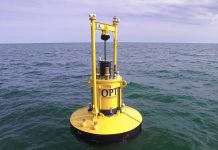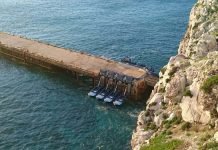by Debra Fiakas CFA
The U.S. Navy is laying claim to the first electric grid connected wave power generator in the country. A test site has been set up near military facilities at Kaneohe Bay in the Hawaiian Islands, where wave activity is known to be exceptional. Yes, Hawaii is part of the United States. The project consists of two wave-power generation systems or ‘power buoys’ anchored about a half-mile off shore. The two buoys are connected by undersea cable to the Marine Corps base at Kaneohe and ultimately to Oahu’s electric power grid.
The first of the two buoys is produced by Northwest Energy Innovations. Its Azura wave energy device was first deployed at the Hawaii test site in June 2015. The buoy sits atop the ocean with about 12 feet rising above the waves and another 50 feet extending below the surface. The system weighs 45 tons and uses both up and down as well as side to side motions to generate electricity. Northwest got help installing the Azura in Hawaii from a contractor, Sea Engineering, which also helped with the assembly and launch. The Azura was developed in collaboration with Callaghan Innovation, a government agency of New Zealand and Energy Hydraulics Ltd., also located in New Zealand.
It seems that ‘takes a village’ to put a wave power buoy into the ocean. The corrosive conditions of salt water and the dangers presented by the unpredictable waves and currents present significant challenges for engineers. Device design, materials, anchoring and grid connections each present unique hurdles.
The second buoy was developed by Fred. Olsen Ltd. based in Great Britain. Its Lifesaver wave power system is a 50-foot wide and 3-feet thick doughnut-shaped device, which is anchored to the ocean floor by cables. It is the action of the cables as the ocean moves that turns the generator. The Lifesaver was put in place at the Hawaii site in April 2016, with help from Healy Tibbitts Builders and Sea Engineering, Inc. The smaller of the two buoys, the Lifesaver is expected to generate about 4 kilowatts.
The Kaneohe projects is a first for the U.S., but not a first for the world. The first grid-connected wave power station in the world was turned on in early 2015 of the coast of Western Australia by the device developer Carnegie Wave Energy Ltd (CWE: AUS or CWGYF: OTC/QB). There are limited ocean power grid connections in the United Kingdom and Norway as well. The U.S. has remained behind developers in these areas where the engineering community has been quicker to embrace innovation and where public policy has been supportive of alternative energy development. Over the past decade the U.S. military has invested about $300 million in hydrokinetic research and development, well behind investments in the United Kingdom, Australia and northern Europe. The Hawaii project has been made possible by financial support from the U.S. Navy, which has interests in reducing energy costs at Hawaii military installations.
The Navy will collect performance data from the Hawaii project in the coming months, which will be used to make adjustments to the power buoys installation as well as to the grid connections. Northwest Energy Innovations also plans changes in its Azura power buoy to increase electric output from 20 kilowatts to 500 kilowatts.
For now the companies involved in the Navy’s project in Hawaii are all privately held and are beyond the reach of most individual investors. Wave power is still in the nascent stages and few ocean power projects underway anywhere have reached the point of generating power on a consistent basis. Some investors might remember solar energy in the 1980s, when solar cells had been proven capable of generating electricity but had not consistently generated profits for any company. With practical knowledge of system design, construction and operation accumulated, the early companies were eventually able to achieve scale and then began generating consistent income streams.
The realization of a full and complete grid connection in Hawaii makes ocean power more certain for U.S. coastal markets. In a study commissioned by the U.S. Department of Energy, RE Vision Consulting estimated that the theoretical ocean wave energy resource potential in the U.S. could satisfy more than 50% of the country’s annual demand. This is a resource that cannot be ignored no matter how challenging the engineering work.
Debra Fiakas is the Managing Director of Crystal Equity Research, an alternative research resource on small capitalization companies in selected industries.
Neither the author of the Small Cap Strategist web log, Crystal Equity Research nor its affiliates have a beneficial interest in the companies mentioned herein.




